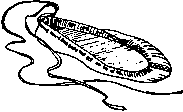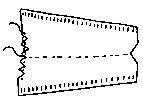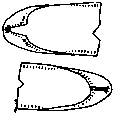These shoes[shoes?:shoes paper pattern cutter] are adapted from Margrethe Hald's book, Primitive Shoes. The patterns given are for a woman size 9. To enlarge them, use an overhead projector (draw around your foot and project the pattern onto the drawing until the foot matches yours as close as possible). You can also use the old squaring method of drawing a grid on the pattern and then redrawing the pattern on an enlarged grid.
The first pair is from the Viking period and is now in the Museum Of Cultural History at Novgorod.
Directions:
Cut slits at marks approximately 3/16" from the edge and as long as the width of the lacing you are going to use ( " is recommended).
Run thread through the 6 points on the toe and pull tightly to gather and then tie off. This will make the toe pucker up and around.
Now sew the front edges of the shoe together. These stitches will show, so the more decorative you can make them, the better. Note the drawing of the original above.
Sew the heel together using a flat seam. Sew it up to about 1" from the top edge.
Cut a long (6' ) lace for each shoe. inch width stays flat and is more comfortable. Lace from the back all the way to the other side. Now pull, pull, and pull to fit. this will be easier if the leather of the shoe is damp. It will also conform to your foot better. Lacings were probably wrapped around the instep of the foot to keep it on.



This is the early shoes, if it use our CUTCNC[CUTCNC?:cutting machine sample maker manufacturer] shoes pattern[shoes pattern?:shoes pattern] cutting machine[cutting machine?:CUTCNC sample maker cutting machine] in the old days, it must be more perfect and time saving.